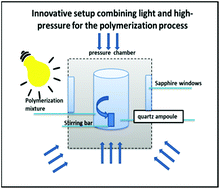Light-mediated controlled and classical polymerizations of less-activated monomers under high-pressure conditions†
Abstract
The innovative combination of light and high pressure allowed us to effectively polymerize for the first time challenging ionic 1,2,4-triazolium-based ionic liquids (ILs) with fluorinate anions (MetTRI/NTF) and non-ionic vinyl acetate (VAc), both classified as less-activated monomers (LAMs). Three different synthetic photo-induced protocols comprising controlled metal-free organocatalyzed Atom Transfer Radical Polymerization (O-ATRP), chain transfer to solvent free-radical polymerization (CT-FRP), and classical free-radical polymerization (FRP) were investigated. As a result, well-defined polymers with a wide range of molecular weights Mn and different concentrations of OH domains incorporated into their polymer backbones in a very short time frame (5–120 min) were produced. Having a series of 1,2,4-triazolium-based poly(ionic liquid)s (PILs), a unique opportunity appeared to study the relationship between their molecular weights, glass transition temperature, and dc conductivity, undoubtedly enriching the library of tailored PILs of enhanced conductivity, a critical parameter determining their serviceability.



 Please wait while we load your content...
Please wait while we load your content...